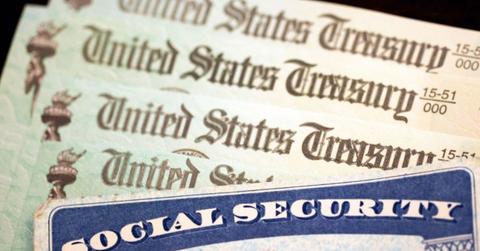What's OASDI on My Paycheck? Social Security Tax, Explained
What's OASDI on my paycheck? The acronym might appear on paychecks instead of FICA. Here's what OASDI means.
Nov. 19 2021, Published 12:12 p.m. ET

If you have ever glanced at your paycheck or pay stub and noticed a deduction labeled “OASDI,” you might not know what it is. Most people likely know this program as Social Security or FICA.
OASDI stands for "Old Age, Survivors and Disability Insurance." The program provides benefits to older Americans after they have paid taxes on earnings to fund the program throughout their working careers. Employees might see this on their paychecks as either OASDI or FICA. Essentially, this is intended to help fund your retirement years.

Rep. Ocasio-Cortez spoke in October about expansion of Social Security benefits.
How is OASDI related to FICA?
The acronyms mean slightly different things, but both are related to retirement benefits. OASDI was created in 1935 with Franklin Roosevelt’s signing of the Social Security Act. Employee paychecks might say OASDI or FICA.
FICA, which stands for "Federal Insurance Contributions Act," includes combined taxes collected for both Social Security and Medicare. OASDI is the official name for Social Security. OASDI funds are meant to partially replace income that's lost due to old age, death of a spouse or qualifying ex-spouse, or disability.
FICA also funds Medicare and consists of hospital insurance for senior citizens and those who are disabled. The Federal Insurance Contributions Act is the legislation that gave the government authorization to collect this tax.
OASDI current tax rate
The OASDI program limits the amount of a person’s earnings that are taxable under the program each year. For 2021, the maximum is $142,800. In 2022, the maximum earnings to be taxed goes up to $147,000. The Social Security Administration calls this the contribution and benefit base.
From that base number, 6.2 percent is the OASDI tax rate in 2022. This rate applies to both employees and employers, which results in a total tax rate of 12.4 percent. However, for self-employed individuals, the total tax rate of 12.4 percent is paid by the individual since there isn't an employer.
What is and isn't included in OASDI or Social Security taxes
Wages that are taxed under the OASDI program to fund Social Security include salaries, bonuses, commissions, and paid vacation or sick leave. Other income such as royalties and honoraria apply.
Meanwhile, “in-kind” payments are taxable as well. The payments include the value of food, clothing, shelter, or other items not paid in cash, according to the SSA. The exceptions are agricultural or domestic workers where in-kind pay counts as unearned income.
If you make elective contributions to a qualified retirement plan, those contributions are subject to FICA tax.
Certain types of income aren't subject to FICA withholding:
Employer-paid health insurance or accident premiums
Health Savings Account (HSA) contributions
In-kind income for domestic or agricultural workers

Sen. Bernie Sanders has also spoken out in favor of Social Security/OASDI expansion to provide more funding from higher earners.
Criticisms of Social Security
One common issue with OASDI or Social Security taxes is that it taxes income only up to a certain point. People with higher incomes don’t pay an equal percentage of their total income.
This is an example of a regressive tax—it taxes 6.2 percent only up to the maximum, which in 2022 is $147,000. Higher earners pay a lower percentage than lower earners. In contrast, a progressive tax would be one where a larger percentage is levied on higher earners.
